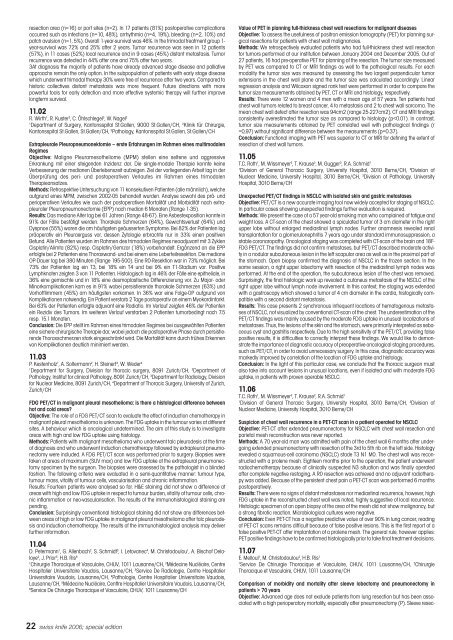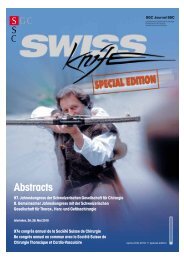Abstracts 4. Gemeinsamer Jahreskongress der ... - SWISS KNIFE
Abstracts 4. Gemeinsamer Jahreskongress der ... - SWISS KNIFE
Abstracts 4. Gemeinsamer Jahreskongress der ... - SWISS KNIFE
You also want an ePaper? Increase the reach of your titles
YUMPU automatically turns print PDFs into web optimized ePapers that Google loves.
swissknife spezial 06 12.06.2006 13:39 Uhr Seite 22<br />
resection area (n=16) or port sites (n=2). In 17 patients (81%) postoperative complications<br />
occurred such as infections (n=10, 48%), arrhythmia (n=4, 19%), bleeding (n=2, 10%) and<br />
patch avulsion (n=1, 5%). Overall 1-year-survival was 46%. In the trimodal treatment group 1year-survival<br />
was 72% and 25% after 2 years. Tumor recurrence was seen in 12 patients<br />
(57%), in 11 cases (52%) local recurrence and in 9 cases (45%) distant metastasis. Tumor<br />
recurrence was detected in 44% after one and 75% after two years.<br />
3At diagnosis the majority of patients have already advanced stage disease and palliative<br />
approachs remain the only option. In the subpopulation of patients with early stage disease<br />
which un<strong>der</strong>went trimodal therapy 30% were free of recurrence after two years. Compared to<br />
historic collectives distant metastasis was more frequent. Future directions with more<br />
powerful tools for early detection and more effective systemic therapy will further improve<br />
longterm survival.<br />
11.02<br />
R. Wirth 1 , R. Kuster 2 , C. Öhlschlegel 3 , W. Nagel 2<br />
1 Department of Surgery, Kantonsspital St.Gallen, 9000 St.Gallen/CH, 2 Klinik für Chirurgie,<br />
Kantonsspital St.Gallen, St.Gallen/CH, 3 Pathology, Kantonsspital St.Gallen, St.Gallen/CH<br />
Extrapleurale Pleuropneumonektomie – erste Erfahrungen im Rahmen eines multimodalen<br />
Regimes<br />
Objective: Maligne Pleuramesotheliome (MPM) stellen eine seltene und aggressive<br />
Erkrankung mit einer steigenden Inzidenz dar. Die single-modale Therapie konnte keine<br />
Verbesserung <strong>der</strong> medianen Überlebenszeit aufzeigen. Ziel <strong>der</strong> vorliegenden Arbeit lag in <strong>der</strong><br />
Überprüfung des peri- und postoperativen Verlaufes im Rahmen eines trimodalen<br />
Therapieansatzes.<br />
Methods: Retrospektive Untersuchung von 11 konsekutiven Patienten (alle männlich), welche<br />
aufgrund eines MPM, zwischen 2002-05 behandelt wurden. Analyse sowohl des prä- und<br />
perioperativen Verlaufes wie auch <strong>der</strong> postoperativen Mortalität und Morbidität nach extrapleuraler<br />
Pleuropneumonectomie (EPP) nach median 6 Monaten (Range 1-35).<br />
Results: Das mediane Alter lag bei 61 Jahren (Range 48-67). Eine Asbestexposition konnte in<br />
91% <strong>der</strong> Fälle bestätigt werden. Thorakale Schmerzen (64%), Gewichtsverlust (64%) und<br />
Dyspnoe (55%) waren die am häufigsten geäusserten Symptome. Bei 82% <strong>der</strong> Patienten lag<br />
präoperativ ein Pleuraerguss vor, dessen Zytologie erbrachte nur in 33% einen positiven<br />
Befund. Alle Patienten wurden im Rahmen des trimodalen Regimes neoadjuvant mit 3 Zyklen<br />
Cisplatin/Alimta (82%) resp. Cisplatin/Gemzar (18%) vorbehandelt. Ergänzend an die EPP<br />
erfolgte bei 2 Patienten eine Thoraxwand- und bei einem eine Leberteilresektion. Die mediane<br />
OP-Dauer lag bei 380 Minuten (Range 195-500). Eine R0-Resektion war in 73% möglich. Bei<br />
73% <strong>der</strong> Patienten lag ein T3, bei 18% ein T4 und bei 9% ein T1-Stadium vor. Positive<br />
Lymphknoten zeigten 3 von 11 Patienten. Histologisch lag in 46% <strong>der</strong> Fälle eine epitheliale, in<br />
36% eine gemischte und in 18% eine desmoplastische Differenzierung vor. Zu Major- o<strong>der</strong><br />
Minorkomplikationen kam es in 91% wobei persistierende thorakale Schmerzen (63%) und<br />
Vorhofflimmern (45%) am häufigsten vorkamen. In 36% war eine Folge-OP aufgrund von<br />
Komplikationen notwendig. Ein Patient verstarb 2 Tage postoperativ an einem Myokardinfarkt.<br />
Bei 63% <strong>der</strong> Patienten erfolgte adjuvant eine Radiatio. Im Verlauf zeigten 46% <strong>der</strong> Patienten<br />
ein Rezidiv des Tumors. Im weiteren Verlauf verstarben 2 Patienten tumorbedingt nach 7.5<br />
resp. 15.1 Monaten.<br />
Conclusion: Die EPP stellt im Rahmen eines trimodalen Regimes bei ausgewählten Patienten<br />
eine sichere chirurgische Therapie dar, wobei jedoch die postoperative Phase durch persistierende<br />
Thoraxschmerzen stark eingeschränkt wird. Die Mortalität kann durch frühes Erkennen<br />
von Komplikationen deutlich minimiert werden.<br />
11.03<br />
P. Kestenholz 1 , A. Soltermann 2 , H. Steinert 3 , W. We<strong>der</strong> 4<br />
1 Department for Surgery, Division for thoracic surgery, 8091 Zurich/CH, 2 Department of<br />
Pathology, Institut for clinical Pathology, 8091 Zurich/CH, 3 Department for Radiology, Division<br />
for Nuclear Medicine, 8091 Zurich/CH, 4 Department of Thoracic Surgery, University of Zurich,<br />
Zurich/CH<br />
FDG PET/CT in malignant pleural mesothelioma: is there a histological difference between<br />
hot and cold areas?<br />
Objective: The role of a FDG PET/CT scan to evaluate the effect of induction chemotherapy in<br />
malignant pleural mesothelioma is unknown. The FDG uptake in the tumour varies at different<br />
sites. A behaviour which is oncological undetermined. The aim of this study is to investigate<br />
areas with high and low FDG uptake using histology.<br />
Methods: Patients with malignant mesothelioma who un<strong>der</strong>went talc pleurodesis at the time<br />
of diagnosis and who un<strong>der</strong>went induction chemotherapy followed by extrapleural pneumonectomy<br />
were included. A FDG PET/CT scan was performed prior to surgery. Biopsies were<br />
taken at areas of maximum (SUV max) and low FDG uptake at the extrapleural pneumonectomy<br />
specimen by the surgeon. The biopsies were assessed by the pathologist in a blinded<br />
fashion. The following criteria were evaluated in a semi-quantitative manner: tumour type,<br />
tumour mass, vitality of tumour cells, vascularisation and chronic inflammation.<br />
Results: Fourteen patients were analysed so far. H&E staining did not show a difference at<br />
areas with high and low FDG uptake in respect to tumour burden, vitality of tumour cells, chronic<br />
inflammation or neo-vascularisation. The results of the immunohistological staining are<br />
pending.<br />
Conclusion: Surprisingly conventional histological staining did not show any differences between<br />
areas of high or low FDG uptake in malignant pleural mesothelioma after talc pleurodesis<br />
and induction chemotherapy. The results of the immunohistological analysis may deliver<br />
further information.<br />
11.04<br />
D. Petermann 1 , G. Allenbach 2 , S. Schmidt 3 , I. Letovanec 4 , M. Christodoulou 1 , A. Bischof Delaloye<br />
2 , J. Prior 5 , H.B. Ris 6<br />
1 Chirurgie Thoracique et Vasculaire, CHUV, 1011 Lausanne/CH, 2 Médecine Nucléaire, Centre<br />
Hospitalier Universitaire Vaudois, Lausanne/CH, 3 Service De Radiologie, Centre Hospitalier<br />
Universitaire Vaudois, Lausanne/CH, 4 Pathologie, Centre Hospitalier Universitaire Vaudois,<br />
Lausanne/CH, 5 Médecine Nucléaire, Centtre Hospitalier Universitaire Vaudois, Lausanne/CH,<br />
6 Service De Chirurgie Thoracique et Vasculaire, CHUV, 1011 Lausanne/CH<br />
22 swiss knife 2006; special edition<br />
Value of PET in planning full-thickness chest wall resections for malignant diseases<br />
Objective: To assess the usefulness of positron emission tomography (PET) for planning surgical<br />
resections for patients with chest wall malignancies.<br />
Methods: We retrospectively evaluated patients who had full-thickness chest wall resection<br />
for tumors performed at our institution between January 2004 and December 2005. Out of<br />
27 patients, 16 had pre-operative PET for planning of the resection. The tumor size measured<br />
by PET was compared to CT or MRI findings as well to the pathological results. For each<br />
modality the tumor size was measured by assessing the two largest perpendicular tumor<br />
extensions in the chest wall plane and the tumor size was calculated accordingly. Linear<br />
regression analysis and Wilcoxon signed rank test were performed in or<strong>der</strong> to compare the<br />
tumor size measurements obtained by PET, CT or MRI and histology, respectively.<br />
Results: There were 12 women and 4 men with a mean age of 57 years. Ten patients had<br />
chest wall tumors related to breast cancer, 4 to metastasis and 2 to chest wall sarcoma. The<br />
mean chest wall defect after resection was 94cm2 (range 25-227cm2). CT and MRI findings<br />
consistently overestimated the tumor size as compared to histology (p 70 years<br />
Objective: Advanced age does not exclude patients from lung resection but has been associated<br />
with a high perioperatory mortality, especially after pneumonectomy (P). Sleeve resec
















